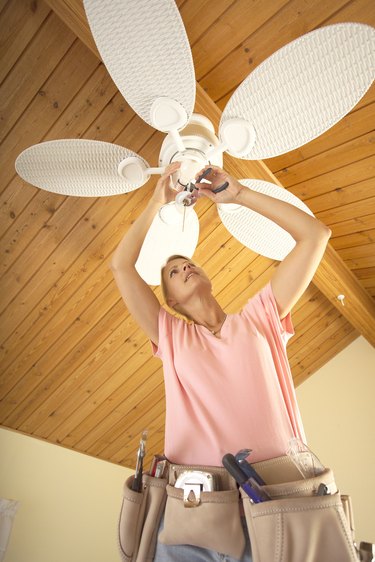 Ceiling pitch affects ceiling fan options.
Ceiling pitch affects ceiling fan options.
A ceiling fan provides hours of cool circulating air, makes living space more comfortable and lowers air conditioning bills. A vaulted ceiling requires a ceiling fan with a sufficient downrod, which is the ceiling fan's neck that connects the wall mount to the top of the fan. The correct downrod length depends on the vaulted ceiling's pitch, angle and height. The room's square footage also is a consideration when determining the best blade-span diameter to accommodate the design.
Video of the Day
Ceiling Pitch
Ceiling pitch is an important factor when determining the proper fan size for a vaulted ceiling. Pitch is the ceiling's steepness or slope. A roof angle finder, which is available at hardware stores, will help you calculate ceiling pitch. The ceiling fan's downrod must be long enough for the fan's blades to clear the ceiling. A fan with a 12-inch downrod works for a vaulted ceiling with a one-quarter- to one-third-inch pitch. An 18-inch downrod is sufficient for a pitch that is five-twelfths to one-half inch. A 24-inch downrod works for pitch that is seven-twelfths to two-thirds inch, and a 36-inch downrod is enough for a pitch of three-quarter inch to 1 inch.
Ceiling Angle
The ceiling's angle is another necessary factor regarding fan size. The angle is measured in degrees and reflects the difference between the ceiling and adjoining walls. Using a roof angle finder and a leveler can help you calculate the ceiling's angle. A ceiling fan with a 12-inch downrod is suitable for a vaulted ceiling that has a 14- to 18.4-degree ceiling angle. Install a ceiling fan with an 18-inch downrod if the angle is 22.6 to 26.5 degrees, a 24-inch ceiling fan for a ceiling with a 30.25 to 33.7 angle and a 36-inch model if the ceiling has a 36.9- to 45-degree angle.
Ceiling Height
Measuring the distance from the floor to the highest point on the vaulted ceiling helps to determine the ceiling fan size that best accommodates the room. As long as the fan blades clear the ceiling, then the fan's height is a matter of personal choice. The lower the fan is in the room, the more you will feel its direct air flow. A ceiling fan with at least a 12-inch downrod accommodates a 10-foot high vaulted ceiling best. An 11-foot ceiling does well with an 18-inch downrod, a 12-foot ceiling with a 24-inch downrod, a 13-foot ceiling with a 36-inch downrod, a 14-foot ceiling with a 48-inch downrod, a 15-foot ceiling with a 60-inch downrod and a ceiling taller than 16.5 feet with a 72-inch downrod.
Fan Width
A ceiling fan's blade span should coordinate with the room's size and function. The blade span is the farthest distance between two tips of the blades. Rooms under 110 square feet need a ceiling fan that has a blade-span diameter no larger than 42 inches. Spaces with a square footage from 110 to 150 feet require a ceiling fan with a 42- to 50-inch blade-span diameter. Rooms from 300 to 450 square feet do well with a 62- to 72-inch blade-span diameter. A ceiling fan that has a 74-inch or larger blade-span diameter is best for larger rooms, such as oversize living rooms, great-rooms, outdoor patios and recreation rooms.






